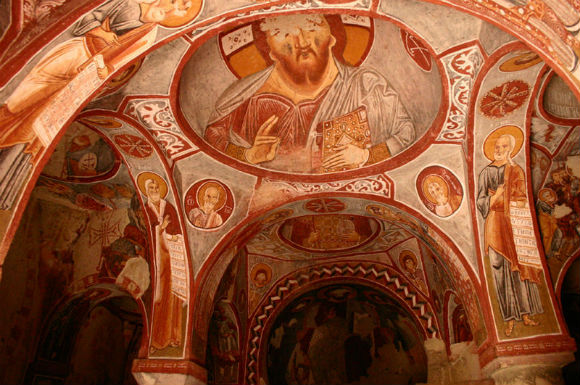This church was carved into the rock at the right side of the road passed the Girl’s convent while going to the region of Churches. A dome was placed over four pillars. It has one big and two small apsises. Although the frescoes of the Ikonoclastic Age remained clean, some broken and separated parts can be seen. On the walls there are pictures symbolizing the sanctif ication of Jesus inside the dome and the baptizing of Jesus, his migration to Jerusalem, the Last Supper, the crucifixion and treachery of one of the Apostles, named Judas. Because a round form, seen in the hand of Jesus Christ appears in one of the pictures on the wall, resembles an apple, this church was called “The Church of the Apple“. But according to some researchers this form actually symbolizes the earth.
Built much later than the others, this the smallest of the churches with column. Once again the artist’s main source of inspiration has been Saints, Prophets and The Life of Christ.
Its gay decoration, its vivid colours make this church one of the brightest and most attractive öl the Cappadocian group.
Elmalı Kilise (Church with the apple) is built in an isolated rock pillar at the far end of the circular group of cliffs in Göreme. The Narthex has disappeared and the present entrance is a kind of oblique pit. The church is of the same shape as Karanlık Kilise but less regular and slightly larger (16’3 x 18’2 feet). All the columns have been preserved: they stand on square bases and have plain abaci. There are three apses with a seat on the right hand side of each; a low bench runs all round the chapel; the altars are set agains the wall. There is no passage between the sanctuary and the chapel of prothesis.
Checkered stripes ornament the pilasters, the walls and the archivolts, while zigzag patterns decorate the bases of the arches, the cupolas and the main tympana. White crosses in red medallions are painted on the small tympana at the angles, and red crosses of the same design but larger at both ends of the transept. Above the small arches are Latin crosses with rounded ends.
The Apple Church or Elmalı Kilise as it is called in Turkish is the latest made and smallest of those in Göreme. The wall paintings that remain are mostly from the period of Byzantine iconoclasm. The lightness of style makes them some of the most attractive of this group. The paintings in the Apple Church depict the Journey to Bethlehem, the Nativity, the Baptism, the Transfiguration, the resurection of Lazarus, the entering into Jeru¬salem, the Last Supper, the betrayal, the road leading to the cross, the Crucifixion, the preparation of th dead, women at the grave, Christ in Purgatory, the ascent into heaven, the hospitality of Abraham, three youths in the furnace, and prophets and a deisis.
Apple Church (Elmalı Kilise),



The frescoes of the Apple Church mostly date from the 11th century. The interesting name probably derives from a red orb held by St. Michael the Archangel in a fresco near the entrance, but an alternative theory is that an apple tree used to grow next to it.